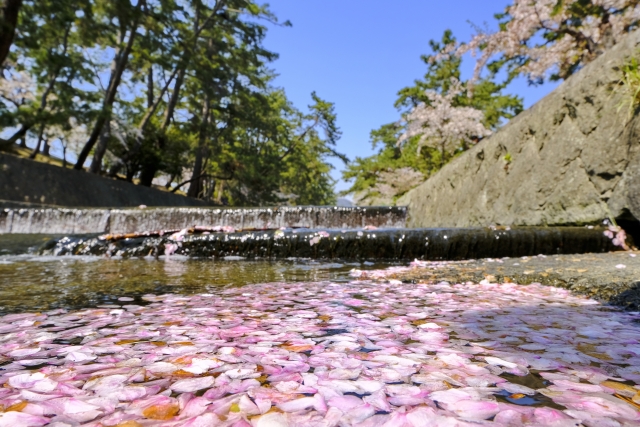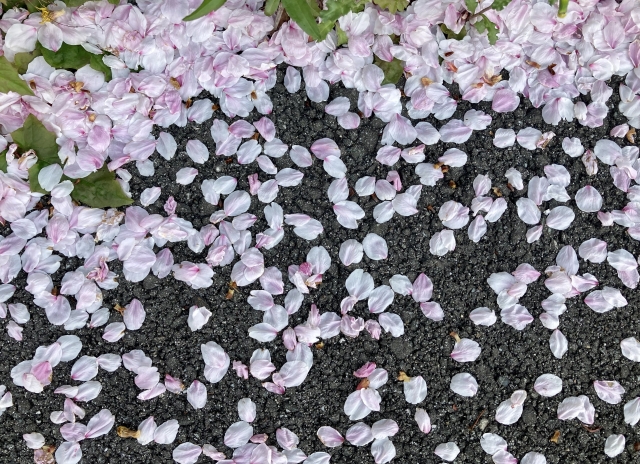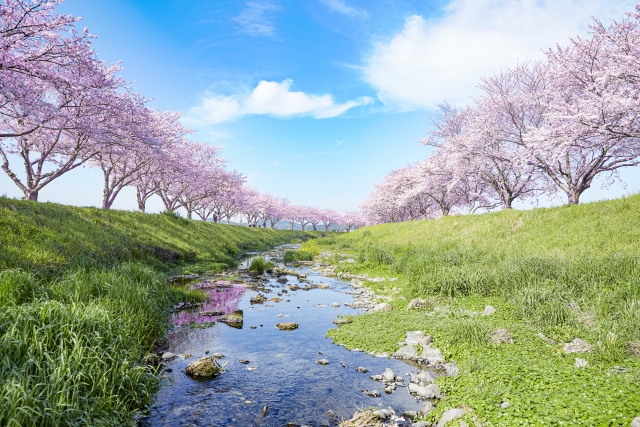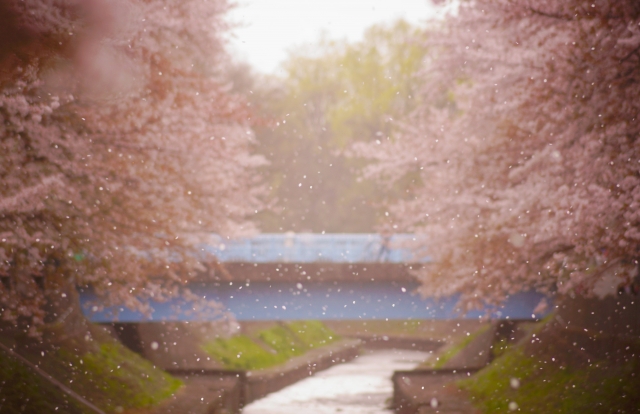Rakka Ryusui (落花流水) is a beautiful Japanese expression that literally means “falling flowers, flowing water.” This poetic phrase captures the enchanting scene of cherry blossom petals floating on streams during spring in Japan. Beyond its visual imagery, this expression carries deeper meanings related to the passage of time, impermanence, and even mutual love. This article explores the rich cultural significance of this expression, its origins, and how it’s used in contemporary Japanese society.
What is “Rakka Ryusui” and How is it Pronounced?

“Rakka Ryusui” (落花流水) is what’s known in Japanese as a yojijukugo (四字熟語) – a four-character idiomatic compound that often conveys a concept more profound than its literal meaning.
The pronunciation is:
- Rakka (落花): “rahk-kah” – meaning “falling flowers”
- Ryusui (流水): “ryoo-sui” – meaning “flowing water”
In Japanese writing, it uses the kanji characters:
- 落 (to fall)
- 花 (flower)
- 流 (to flow)
- 水 (water)
The Multiple Meanings of Rakka Ryusui
This expression carries several layers of meaning in Japanese culture:
A Beautiful Spring Landscape
The most basic meaning of Rakka Ryusui describes the picturesque scenery of flower petals (particularly cherry blossoms) falling into streams or rivers during late spring. This image is deeply embedded in Japanese aesthetic appreciation of nature.
In Japan, this sight is especially associated with sakura (cherry blossoms) – the national flower that blooms for only a brief period each year. When cherry blossom petals detach and drift on water surfaces, they create a mesmerizing natural display that Japanese people have admired for centuries.
The Flow of Time and Impermanence
Beyond the literal image, Rakka Ryusui represents the Buddhist concept of impermanence (mujō – 無常). The falling petals symbolize the fleeting nature of beauty and life, while the flowing water represents the unstoppable passage of time.
This philosophical interpretation connects to the Japanese aesthetic concept of mono no aware (物の哀れ) – the pathos of things or the gentle sadness in the transience of life. When Japanese people observe cherry blossoms falling into streams, they often contemplate how:
- Beauty is temporary
- Life is constantly changing
- Time passes without pause
A Symbol of Mutual Love
Perhaps most interestingly for non-Japanese readers, Rakka Ryusui also serves as a romantic metaphor for mutual attraction. In this interpretation:
- The flowers (traditionally representing the man) wish to entrust themselves to the flowing water
- The water (traditionally representing the woman) wishes to carry the flowers along its journey
This creates a beautiful symbol of two entities naturally drawn to each other – a perfect harmony in which both parties desire to be together.
| Meaning | Description | Usage Context |
|---|---|---|
| Natural Scenery | Physical image of petals on water | Nature appreciation, spring poetry |
| Impermanence | Philosophical reflection on time | Literature, philosophical discussions |
| Mutual Love | Symbol of reciprocal attraction | Romantic contexts, relationship descriptions |
The Cultural Origins of Rakka Ryusui

Like many Japanese expressions, Rakka Ryusui has fascinating historical roots:
Chinese Poetry Roots
The expression originated in ancient Chinese poetry, dating back to the Tang Dynasty (618-907 CE). Chinese poets used this imagery to evoke natural beauty and philosophical contemplation.
One famous appearance was in poet Gao Pian’s work “Visiting a Recluse But Not Meeting Him,” which contains the line: “Recognizing the scene of fallen flowers and flowing water at Mount Tiantai, half-drunk I came alone, humming verses.”
Another important reference comes from a 13th-century Zen text called “Shōyōroku” (従容録), which contains the phrase: “Fallen flowers follow the flowing water with intention, while the flowing water carries the fallen flowers without emotion.” This line influenced Zen philosophy and the understanding of natural harmony.
Adaptation in Japanese Culture
When this expression reached Japan, it was embraced and transformed through the lens of Japanese cherry blossom culture. While Chinese poets may have originally envisioned peach or plum blossoms, Japanese culture naturally associated the image with sakura.
The Japanese interpretation added emotional depth, particularly connecting the expression to:
- The hanami (花見) tradition of flower viewing parties
- The cultural appreciation of transient beauty
- The romantic symbolism unique to Japanese literary traditions
The renowned Japanese novelist Nagai Kafū mentioned this expression in his diary “Danchōtei Nichijō,” showing how the concept had become integrated into Japanese literary consciousness.
How to Use Rakka Ryusui in Contemporary Japan

Modern Japanese people use this expression in several contexts:
For Describing Nature and Seasons
- “The cherry trees have begun shedding their petals, creating a beautiful rakka ryusui scene along the riverbank.”
- “Early April brings the magical rakka ryusui landscapes that inspire Japanese poets and artists.”
- “Photographers gather at the old stone bridge to capture the perfect rakka ryusui moment when petals dance on the water’s surface.”
As a Romantic Expression
- “From their first meeting, they were drawn to each other like rakka ryusui – a naturally perfect match.”
- “Their relationship has the quality of rakka ryusui, each complementing the other beautifully.”
- “After years of marriage, they still maintain their rakka ryusui connection, moving through life in perfect harmony.”
The Japanese also use the extended phrase “Rakka Ryusui no Jō” (落花流水の情) to specifically emphasize the romantic feeling of mutual attraction.
Philosophical and Temporal Reflections
- “In our busy modern lives, time passes like rakka ryusui, flowing away before we realize it.”
- “The changing seasons remind us of rakka ryusui – nothing remains the same forever.”
- “The rise and fall of trends follows the pattern of rakka ryusui – beauty fades and something new takes its place.”
Similar Japanese Expressions Related to Nature
Japan has many other beautiful yojijukugo expressions that, like Rakka Ryusui, use natural imagery to convey deeper meanings:
| Expression | Pronunciation | Literal Meaning | Deeper Meaning |
|---|---|---|---|
| 花鳥風月 | Kachō Fūgetsu | Flowers, birds, wind, moon | The beauty of nature; traditional aesthetic subjects |
| 風林火山 | Fūrin Kazan | Wind, forest, fire, mountain | Strategic principles (from military tactics) |
| 明鏡止水 | Meikyō Shisui | Clear mirror, still water | A calm, undisturbed mind |
| 鏡花水月 | Kyōka Suigetsu | Mirror flower, water moon | Something beautiful but unattainable or illusory |
Related Expressions to Rakka Ryusui
It’s worth noting a similar but distinctly different expression: “Rakka Yūi, Ryusui Mujō” (落花有意・流水無情). This phrase means “falling flowers have intention, flowing water has no feeling,” suggesting unrequited love rather than mutual attraction.
The contrast between these expressions shows how subtle shifts in meaning can completely change the emotional impact:
| Expression | Meaning | Relationship Dynamic |
|---|---|---|
| Rakka Ryusui | Both elements naturally drawn together | Mutual love, reciprocal feeling |
| Rakka Yūi, Ryusui Mujō | Flowers fall wanting to be carried, but water flows indifferently | One-sided love, unrequited feelings |
How to Appreciate Rakka Ryusui in Japan

If you visit Japan during spring, you can experience the literal meaning of Rakka Ryusui firsthand:
Best Places to Witness Rakka Ryusui Scenes
- Philosopher’s Path (Kyoto): A canal lined with cherry trees where petals create magnificent floating patterns
- Meguro River (Tokyo): Urban cherry tree-lined waterway famous for its petal-strewn waters
- Hirosaki Castle (Aomori): The moat becomes covered with a carpet of pink petals
- Shingashi River (Kawagoe): Famous for its weeping cherry trees that drop petals directly into the water
Best Time to See Rakka Ryusui
The ideal time is 1-2 days after peak bloom when cherry blossoms begin to release their petals. This usually occurs:
- Late March to early April in Tokyo and Kyoto
- Mid to late April in northern regions
Photography Tips
To capture the essence of Rakka Ryusui:
- Look for areas where cherry trees hang over flowing water
- Visit early morning when winds are gentle and light is soft
- Use a polarizing filter to reduce water glare
- Try both fast shutter speeds to freeze petals and slow speeds to capture the flowing movement
Conclusion
Rakka Ryusui offers a window into Japanese cultural aesthetics, combining natural beauty, philosophical depth, and romantic symbolism in just four characters. From ancient Chinese poetry to modern Japanese romance, this expression has evolved while maintaining its core visual imagery of flower petals dancing on flowing water.
Understanding expressions like Rakka Ryusui helps non-Japanese appreciate the nuanced way Japanese language intertwines nature, human emotions, and philosophical thought. Next time you see flower petals floating on water, you might remember this beautiful Japanese concept and the layers of meaning it contains – a perfect example of how language can capture both visual beauty and emotional depth in just a few syllables.


